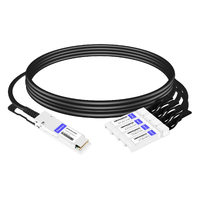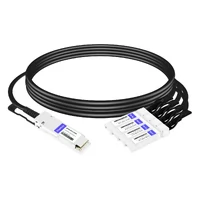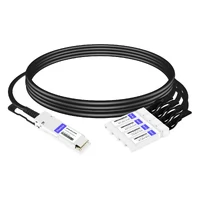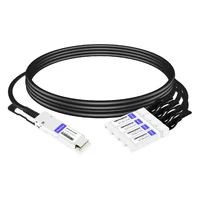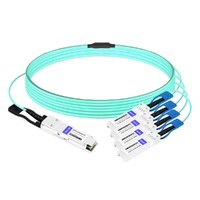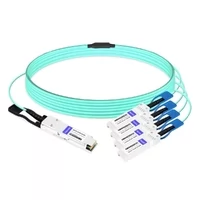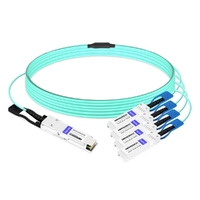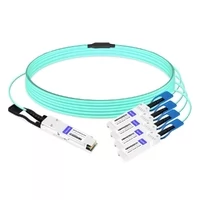Breakout cables have become a critical component for achieving faster data transfer rates in data centers and high-speed network environments. With the need for increased bandwidths and more efficient transmissions among organizations, it becomes important to know what QSFP28 breakout cables do and where they can be used. This article seeks to give an all-encompassing view of QSFP28 breakout cables by looking at their design, operational features, and benefits in today’s networking infrastructures. Readers will, therefore, understand why these are seen as key building blocks for modern high-capacity data networks by delving into some technicalities and deployment scenarios.
Table of Contents
ToggleWhat is a QSFP28 Breakout Cable?
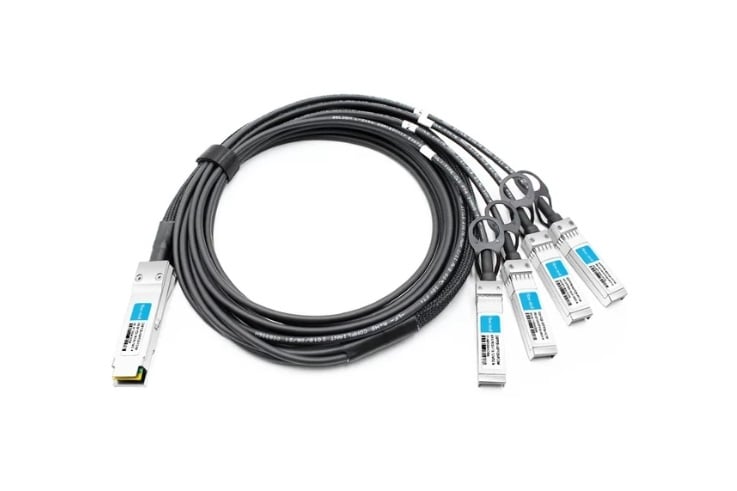
Defining QSFP28 and Breakout Cables
A QSFP28 breakout cable is a kind of high-speed connectivity solution that is created for data centers and other places where high-performance computing happens. The 28 in QSFP28 means that each lane of this interface can support up to 28 Gbps, thus giving us 100 Gbps for four lanes. With these cables it’s possible to split one port into four separate ports – usually SFP28 ones – thereby allowing flexible and efficient network configuration. QSFP28 breakout cables enable devices running at different speeds to be connected with each other while saving ports at the same time, so that overall bandwidth efficiency and network performance could be improved.
Common Applications of QSFP28 Breakout Cables
High-density data center environments and high-performance computing (HPC) clusters commonly use QSFP28 breakout cables. They are ideal for situations where one wants to increase port utilization efficiency while managing bandwidth, among many other things that need consideration in such a network system design, because they can break down a single high-speed port into multiple lower-speed connections. Here are some examples where they may be applied:
- Data Center Interconnections: These are used to connect switches, routers and servers within data centers in order to improve network flexibility which will in turn lead to better resource allocation optimization.
- Cloud Computing Platforms: These cables facilitate fast communication between servers as well as storage systems within any given cloud infrastructure so that there is no point where information is unreachable or delayed when it should have been processed at those speeds anyway.
- Enterprise Networks: Enterprise networks often require different devices running at different speeds to be interconnected efficiently; this is where the versatility of QSFP28 breakout cable comes into play.
- High-Performance Computing: In an HPC environment, huge amounts of data are handled very quickly, hence the need for fast and efficient connectivity solutions like these ones, which provide enough bandwidth for such tasks.
By using them across these areas, organizations will get improved network efficiency, scalability, and performance necessary to meet the needs of modern computer workloads that keep increasing by the day.
Benefits of Using QSFP28 Breakout Cables
The QSFP28 breakout cable has a variety of features that can greatly improve network operations and efficiency:
- Cost-effective: By allowing one high-speed port to be split into several lower-speed connections, QSFP28 breakout cables reduce the need for more hardware, resulting in lower infrastructure costs overall.
- High bandwidth with low latency: These cables support data rates up to 100 Gbps, ensuring fast data transmission with minimal delay – a critical factor for high-density data centers and high-performance computing.
- Scalable and flexible: QSFP28 breakout cables offer different kinds of connectivity options that help networks scale dynamically as traffic demands increase. This means they can be easily integrated into existing infrastructure to allow adaptive and efficient management of networks.
- Better performance: These cables enhance bandwidth efficiency as well as overall network performance by optimizing the use of available ports; this is necessary for cloud computing platforms or enterprise networks that need strong reliable connections.
QSFP28 breakout cables enable organizations to create streamlined, cost-efficient, high-performance network environments that meet the requirements of modern data and computing operations.
How to Choose a QSFP28 Breakout Cable?
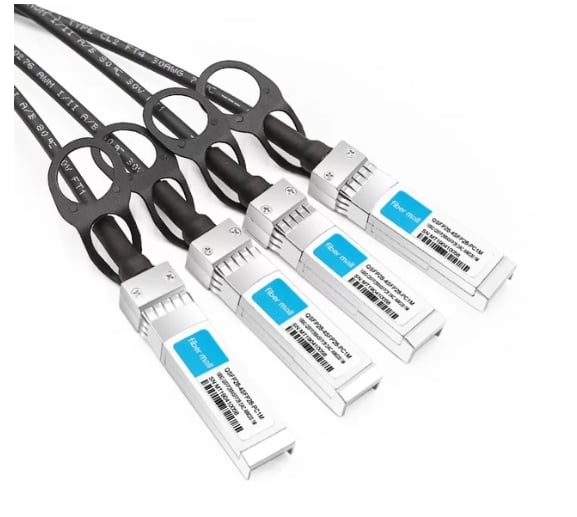
Compatibility with Existing Infrastructure
When deciding on a breakout cable QSFP28, you must make sure that it is compatible with your current network infrastructure. This will guarantee its smooth integration and maximum performance. These are the main points to consider:
- Hardware Compatibility: Check if the QSFP28 breakout cables can work with your network devices, switches and transceivers. You can go through the manufacturer’s specifications or use online tools from major vendors for compatibility verification.
- Cable Length and Type: The cable length and type should be able to meet the physical as well as environmental requirements of where they are deployed in your network. Different places such as data centers or enterprise networks may have different needs when it comes to cable management and installation.
- Firmware And Software Support: Ensure that firmware updates that are applicable with QSFP28 breakout cables can be supported by networking hardware used at hand. This will enable such cables to utilize all features provided within an existing infrastructure without causing any disruptions or problems of compatibility.
By considering these factors for compatibility, one can integrate QSFP28 breakout cables into their system, thus optimizing performance while keeping operational efficiency.
Performance Metrics to Consider
When evaluating QSFP28 breakout cables, there are a few key performance metrics that must be considered to ensure optimal network effectiveness and efficiency:
- Data Rate/Bandwidth: Typically these cables offer 100 Gbps data transfer speed which should be checked for high-bandwidth handling ability and prevention of any data loss.
- Latency: Look at the latency numbers provided by the manufacturer because it is necessary to have low latency performance especially when dealing with time-sensitive applications. This means signals should not take too long.
- Signal Integrity: Test things like bit error rate (BER) or crosstalk levels – these are indicators used in measuring how good wires communicate among themselves without causing any interference, which might result in failure during transmission.
- Power Consumption: It’s important also considering power consumption as this can contribute towards energy saving hence reducing operational costs within your organization. A cable should follow power efficiency guidelines set by relevant bodies.
- Thermal Performance: Ensure that such kind of cable can survive under different thermal environment conditions where it will be deployed at various times. Otherwise if not managed well heat produced may lead to overheating problems thereby affecting overall system operation stability.
By thoroughly investigating these factors, businesses can pick suitable QSFP28 breakout cables that fit their particular networking needs so that strong, reliable data sharing is achieved throughout the company.
Customer Reviews and Recommendations
When purchasing QSFP28 breakout cables, people usually notice the following aspects according to customer reviews and professional advice:
- Quality of the Cable: It is always mentioned by the clients that good materials should be used in manufacturing this product coupled with strong construction. The longevity and dependability of such connectors have a significant effect on performance over time as well as maintenance costs.
- Performance Metrics: Low latency performance, signal integrity excellence and lack of crosstalk are among some frequently cited measures for success in reviews. Users want high data rate cables which can keep up with large bandwidth requirements but not at the expense of these qualities.
- Ease of Installation: Recommendations frequently highlight how easy it is to install them onto already existing network devices. User satisfaction tends to increase if they can just plug and play without any confusion due to poor labeling or unclear instructions given by sellers on what each connector does exactly when connected together, etcetera.
- Cost-Effectiveness: When talking about cost, many compare prices against their capabilities stated by reviewers who mention this factor consistently throughout all comments analyzed so far. They expect those which deliver top performances at affordable rates thus giving value for money invested into Qsfp 28 breakout cable infrastructure needed for networking purposes.
In conclusion, one should take into account quality, performance, ease of use and affordability while selecting QSFP28 breakout cables based on other customers’ feedback from reputable sources.
What Types of QSFP28 Breakout Cables are Available?
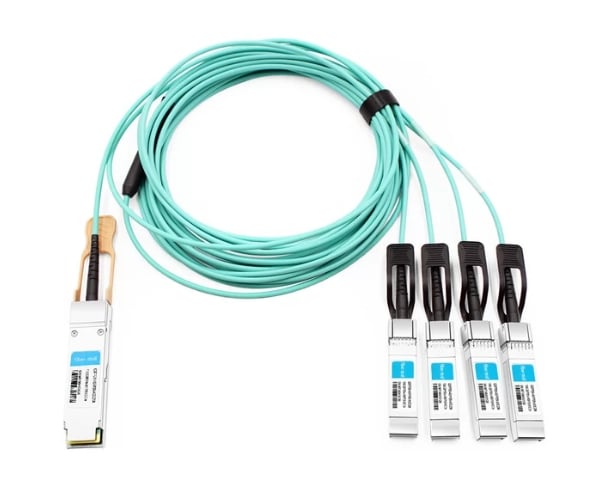
QSFP28 to 4x SFP28 Breakout Cables
In high-speed information centers, QSFP28 to 4x SFP28 breakout cables are important components that help in linking a 100G (QSFP28) and four 25G (SFP28) ports. These cords support high-density as well as high-bandwidth network applications thus allowing versatility in design of networks. They usually come in two versions which include: active and passive.
- Passive copper cables (DACs): They are used for short distance connections of up to 5 meters without requiring any additional power supply. Being cost effective with low latency makes them ideal for intra-rack and inter-rack connections within the same room.
- Active optical cables (AOCs): AOCs are designed for longer distances where they use optic fibers to transmit data while incorporating electrical-to-optical conversion at cable ends. They can support up to 100 meters or more with low power consumption, high performance and minimum signal interference.
- Breakout Cables with MTP/MPO Connector: MTP/MPO optical breakout cables used with breakout modules provide scalable solutions for environments that demand high density. They can work with different types of fiber and be tailored according to specific network configurations thus promoting efficient management of cables.
Essentially, through enabling seamless cost effective expansion of networks, these modern days’ data centres benefit from flexibility, efficiency and performance delivered by QSFP28 to 4x SFP28 breakout cables.
Passive vs. Active Optical Cables
To figure out whether passive or active optical cables (AOCs) should be used in a data center environment, you need to know the requirements for distance, power consumption and performance. Passive optical cables are made from copper and are used for short-range connections that don’t exceed 5 meters usually. These cables do not demand extra power to transmit a signal, so they have a low latency, which is cheap on top of being suitable mostly within a rack and between racks that are close to each other.
Conversely, active optical cables use optic fiber technology alongside electrical-optical conversion devices located on both ends of a cable to allow for long-distance data transmission which can cover up to or more than 100 meters in some cases. AOCs work best where there is a need for minimum signal loss, less electromagnetic interference as well as higher data rates. Although they may be costly compared to their counterparts without any activity such as these ones, but still their better power efficiency levels coupled with good signal quality make them ideal for specific network architectures.
In conclusion, it is important to take into account the trade-offs between distance, cost, and performance aspects required by different types of data centers when choosing between passive and active optical cables.
Direct Attach Copper Breakout Cables
Direct Attach Copper (DAC) breakout cables provide an effective, low-cost way to make high-speed connections within data centers. They are made up of many twinaxial cables with one connector at one end splitting into several connectors at the other, and this is key for dense networking. The most common use case for DAC breakout cables is short-distance, high-bandwidth data transfers over a few meters, usually between switches and servers or storage devices within the same rack or neighbouring racks.
Low latency, reduced power consumption, and simplified connectivity – obviating the need for extra transceivers – are among the main advantages of using DAC breakout cables. These types of cable support various data rates, such as 10 Gbps, 25 Gbps, 40 Gbps, and 100 Gbps, to address different bandwidth demands in contemporary data centers. Additionally, being plug-and-play compatible ensures that they can be deployed quickly without much configuration needed, thus improving operational efficiency.
In conclusion it could be said that Direct Attach Copper breakout cables offer reliable yet cheap solution towards high density short distance networks in data centres where efficiency matters most but also keeping up with speed requirements across different areas of operation.
How to Ensure QSFP28 Breakout Cable Compatibility?
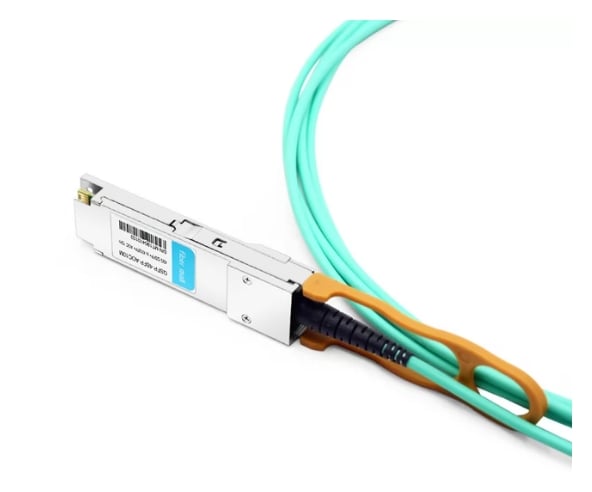
Understanding MSA Standards
The compatibility and interoperability of Multi-Source Agreement (MSA) standards are very important especially in different vendors’ networking equipment where QSFP28 breakout cables are concerned. Several manufacturers collaborate to form MSAs so that they can outline the mechanical, electrical and optical specifications for transceivers as well as connectors thus making sure they meet common requirements.
In relation to QSFP28 breakout cables, compliance with MSA standards involves sticking by certain specifications like the form factor, electrical interface, light source and signal processing. These rules guarantee that an authorized QSFP28 module or cable will function seamlessly with network gear from different suppliers thereby minimizing chances of having compatibility problems.
For instance, the key among MSA standards is SFF-8665, which governs the electrical and mechanical features of a QSFP28, while SFF-8024 gives instructions on connector and cage assemblies. Operators who follow these guidelines can be confident that their QSF+P28 breakout cables are performing well on different devices, thus supporting trouble-free integration and operation within various networking environments.
To sum up, awareness plus conformity towards MSA standards should not be taken lightly because failure to abide by them may lead to unreliable performance of QSFP 28 breakout cables across multi-vendor network ecosystems hence hindering dependable high-performance data center operations.
Checking for Cisco and Arista Compatibility
To know this compatibility of QSFP28 breakout cables with Cisco and Arista devices, there is a need to follow what these vendors give as their specific matrices for compatibility and other documentation.
Cisco Compatibility:
Cisco’s official QSFP-100G-CU* series cables have been created in such a way that they meet the strictest standards required by Cisco in terms of compatibility, which ensures that they work reliably. They are included in Cisco’s transceiver module compatibility matrix table under QSFP28 breakout cables that can be found in their support and documentation portals. This record provides all details about transceivers supported, cable types used together with recommended configurations for various routers plus switches made by Cisco.
Arista Compatibility:
Also, Arista has an extensive Transceiver & Cable Guide which lists down every supported model number for QSFP28 breakout cables alongside its corresponding hardware models where it can operate best. These documents describe only those modules based on QSFP28 form factor tested as well approved for use with Arista switches while at the same time stating maximum distances supported according to MSA or SFF specifications so that compliance is ensured. Following these instructions will enable network operators achieve smooth integration as well as peak performance of their own QSFP28 breakouts within an environment running on an Arista platform.
In conclusion, when determining whether or not your chosen QFSP 20Gbps fiber optic patchcord will work seamlessly between different vendor products like CISCO or ARISTA, one should always refer back to each vendor’s specific matrix tables provided alongside official documentation. Once you do this, you can be certain that your network deployment shall be robust enough to handle multi-vendor interoperability besides being highly reliable with a maximum throughput capacity of at least up to 100Gbps.
What Are the Key Features of QSFP28 Breakout Cables?
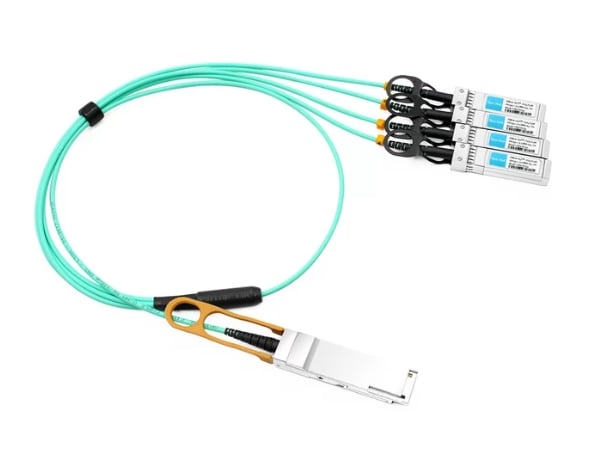
Power Consumption and Efficiency
QSFP28 breakout cables were constructed keeping in mind that they should be efficient and, at the same time, consume less energy as they transfer data. In most cases, these wires use about 3.5 watts per module, which is much less than what is used by traditional transceivers. This feat is made possible through modernized design concepts that limit power wastage due to leakage while at the same time improving signal strength through better materials, among other things. Additionally, QSFP28 modules can have features that save energy, such as adaptive power management, which varies with operational needs, and so on. Generally speaking, using low-power QSFP28 breakout cables lowers operation costs besides reducing heat dissipation, thereby making data centers more energy efficient.
Data Transfer Rates of Up to 100G
Breakout cables QSFP28 can support data rates of up to 100 gigabits per second (Gbps). This speed is only possible because of PAM4 (Pulse Amplitude Modulation) and other materials that help keep the transmission medium from losing much signal quality. Each module splits into 4x25G or 2x50G channels, making it useful for various purposes in current high-performance computing environments. This 100G data rate works well where there are large amounts of data being transmitted at once with low delays such as huge warehouses storing information or business networks connecting different buildings together rapidly while trading stocks frequently within milliseconds. Therefore, these cables are necessary to meet growing demands for faster speeds and more reliable connections between devices on a network.
Durability and Reliability Factors
When deploying QSFP28 breakout cables in data centers, durability and reliability are of utmost importance. They are made from strong materials which make them perform well for longer periods without getting worn out easily through physical contacts. Electromagnetic interference (EMI) and physical damage protection can be achieved by using high-quality copper together with special kinds of shields designed specifically for this purpose. Besides, they have frequent plugging and unplugging endurance ability due to their design that supports dynamic network construction.
Manufacturing methods are strict and testing is intense so as to ensure more dependable service provision. Standards provided by IEEE or IEC, among others, control how these wires function within the industry while being produced in large quantities worldwide. Following such rules guarantees uniform quality levels throughout all applications where QSFP28 breakout cables may be used thus improving their reliability greatly. Such a combination of tough building components coupled with strictness towards what should pass off as acceptable contributes towards making them dependable enough for use in present-day high-speed networks.
Reference sources
- Cisco
- White Paper: “Understanding QSFP28 Breakout Cable Technology”
- URL: Cisco
- Summary: The technical aspects and applications of QSFP28 breakout cables for high-speed data transfer are discussed in this white paper by Cisco, which also provides detailed insights into their technology and deployment in networking environments.
- FS.com
- Blog Post: “Demystifying QSFP28 Breakout Cables: A Comprehensive Guide”
- Summary: According to this blog post by FS.com, QSFP28 breakout cables can be optimized for high-speed data transfer in data centers and enterprise networks. The article covers uses, benefits, and best practices.
- Arista Networks
- Technical Documentation: “QSFP28 Breakout Cables Deployment Guide”
- Summary: To efficiently transfer data at a high speed, Arista Networks’ technical documentation recommends different performance considerations for configuration tips on deploying QSFP28 breakout cables across various devices with compatibility information.
Frequently Asked Questions (FAQs)
Q: What does QSFP28 Breakout Cables mean?
A: A high-speed cable assembly that allows a QSFP28 transceiver to be split into multiple SFP28 transceivers for effective data center network management and expansion.
Q: How is 100g compatible with SFP28?
A: 100g QSFP28 can be divided into multiple 25g SFP28 through breakout DAC cable or breakout AOC cable, which greatly improves the flexibility of 100Gbps networking.
Q: What are the differences between passive and active breakout cables?
A: Passive breakout cables (such as passive direct attach copper breakout cables) have no signal amplification built-in, while active ones (AOC) have electronics that actively boost the signal, usually allowing for longer distances and better signal integrity.
Q: What applications benefit from using a QSFP28 to 2x or 4x 25g SFP28 setup?
A: Such setups are useful in high-performance computing, data center interconnects, high-density Ethernet switches, etc., as they improve bandwidth utilization and scalability.
Q: Are passive direct attach cables tested individually for individual performance?
A: Yes, each passive DAC cable, including the breakout DAC cable – Volex, is tested individually to ensure the best performance in data centers.
Q: What lengths are available for passive QSFP28 breakout cables?
A: Passive copper cables and passive direct attach copper breakout cables typically range from 0.5m to 7m in length, catering to different requirements in data centers.
Q: How do QSFP28 DAC cables help reduce power consumption?
A:QSFP28 DAC cables especially passive DAC consume less power compared with active optical cables (AOC) since they don’t need extra electrical components to amplify signals thereby making them energy efficient for short range connections.
Q: Can I use QSFP28 breakout cables on my 25G Ethernet deployments?
A: Yes, QSFP28 breakout cables can be used for 25G Ethernet deployments by splitting a 100G QSFP28 connection into multiple 25G SFP28 passive direct attach copper connections, thus enabling high-speed data transfer and flexible network scaling.
Q: What is the role of DAC Twinax cable in QSFP28 breakout connections?
A: DAC Twinax cables are important in QSFP28 breakout connections as they provide a cost-effective, low-latency, and high-performance medium for dividing 100G connections into several 25G links to ensure efficient data transmission within a data center environment.
Related Products:
-
 QSFP28-4SFP28-PC1M 1m (3ft) 100G QSFP28 to Four 25G SFP28 Copper Direct Attach Breakout Cable
$50.00
QSFP28-4SFP28-PC1M 1m (3ft) 100G QSFP28 to Four 25G SFP28 Copper Direct Attach Breakout Cable
$50.00
-
 QSFP28-4SFP28-PC2M 2m (7ft) 100G QSFP28 to Four 25G SFP28 Copper Direct Attach Breakout Cable
$65.00
QSFP28-4SFP28-PC2M 2m (7ft) 100G QSFP28 to Four 25G SFP28 Copper Direct Attach Breakout Cable
$65.00
-
 QSFP28-4SFP28-PC3M 3m (10ft) 100G QSFP28 to Four 25G SFP28 Copper Direct Attach Breakout Cable
$80.00
QSFP28-4SFP28-PC3M 3m (10ft) 100G QSFP28 to Four 25G SFP28 Copper Direct Attach Breakout Cable
$80.00
-
 QSFP28-4SFP28-PC5M 5m (16ft) 100G QSFP28 to Four 25G SFP28 Copper Direct Attach Breakout Cable
$120.00
QSFP28-4SFP28-PC5M 5m (16ft) 100G QSFP28 to Four 25G SFP28 Copper Direct Attach Breakout Cable
$120.00
-
 QSFP28-4SFP28-AOC1M 1m (3ft) 100G QSFP28 to Four 25G SFP28 Active Optical Breakout Cable
$169.00
QSFP28-4SFP28-AOC1M 1m (3ft) 100G QSFP28 to Four 25G SFP28 Active Optical Breakout Cable
$169.00
-
 QSFP28-4SFP28-AOC3M 3m (10ft) 100G QSFP28 to Four 25G SFP28 Active Optical Breakout
$173.00
QSFP28-4SFP28-AOC3M 3m (10ft) 100G QSFP28 to Four 25G SFP28 Active Optical Breakout
$173.00
-
 QSFP28-4SFP28-AOC5M 5m (16ft) 100G QSFP28 to Four 25G SFP28 Active Optical Breakout Cable
$176.00
QSFP28-4SFP28-AOC5M 5m (16ft) 100G QSFP28 to Four 25G SFP28 Active Optical Breakout Cable
$176.00
-
 QSFP28-4SFP28-AOC10M 10m (33ft) 100G QSFP28 to Four 25G SFP28 Active Optical Breakout Cable
$185.00
QSFP28-4SFP28-AOC10M 10m (33ft) 100G QSFP28 to Four 25G SFP28 Active Optical Breakout Cable
$185.00

